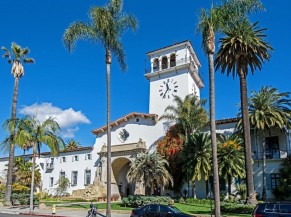From red-tile clay roofs to street names, the architecture of Santa Barbara is infused with the spirit of Spain. Many buildings, the Santa Barbara County Courthouse and Old Mission Santa Barbara to name just two, appear plucked directly from Madrid. So how did Santa Barbara get a Spanish start? It began in 1602 when explorer Sebastián Vizcaíno, sailing from Spanish-ruled Mexico, survived a huge storm on the eve of Saint Barbara’s feast day. He named the channel and an island in her honor—and soon, the city of Santa Barbara was born.
The Spaniards then returned 167 years later. Gaspar de Portolá and Franciscan priest Junípero Serra arrived overland from Mexico to establish missions and forts in “Alta” California to secure the region for Spain.
Soon, the Old Mission and El Presidio fort were built (both can be toured today), and soldiers from Portolá’s party settled here. Downtown streets—De la Guerra, Cota, Gutierrez, Ortega and Carrillo—memorialize these early residents. California joined the United States in 1850. A botched 1851 survey left Santa Barbara with misaligned streets and inconsistent block sizes. Blame Salisbury Haley, who tied his survey chains with rawhide that shrunk and swelled with the weather. (In spite of his goofs, Haley got a street named for him.) The coastline runs east-west here and provides a southern exposure and mild climate similar to that of southern France. This earned the city a nickname, The American Riviera®.
Fast forward to 1925, when downtown was shaken into rubble by a 6.8 magnitude earthquake. Architecturally, the earthquake was a big win for the city: Civic leader Pearl Chase convinced city planners to rebuild in a unified Spanish Colonial Revival style inspired by the Old Mission and recently completed Lobero Theatre. Her creative efforts, seen in the iconic red-tile roofs and whitewashed adobe walls, are remembered in a delightful beachside park named in her honor.
Many buildings here date from that era: The Santa Barbara County Courthouse, with its Moorish flourishes; the hidden courtyard and fountains of El Paseo and countless white stucco buildings adorned with ornamental iron work, painted tiles, and arched doorways.
Each August, a five-day city-wide fiesta celebrates Santa Barbara’s “Old Spanish Days” with parades, performances and a rodeo. ¡Viva España!




